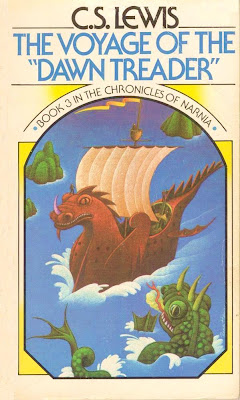The Voyage of the Dawn Treader (1952) is a children’s fantasy novel, the third in C. S. Lewis’s Chronicles of Narnia. Here, Edmund and Lucy, along with their insufferable cousin Eustace, are pulled into Narnia to aid Caspian in his search for seven missing Narnian lords.
(1952) is a children’s fantasy novel, the third in C. S. Lewis’s Chronicles of Narnia. Here, Edmund and Lucy, along with their insufferable cousin Eustace, are pulled into Narnia to aid Caspian in his search for seven missing Narnian lords.
There isn’t much of an overarching plot here as there are in Lewis’s prior novels; it’s much more episodic, as the Dawn Treader sails to one island after another, and to one adventure after another. And this is why the novel works so well: Lewis has given himself complete narrative freedom to do whatever he wants, and he uses the full measure of his wondrous imagination. The unexpected is here in a way unlike the previous stories, and The Voyage of the Dawn Treader has throughout it the full and free spirit of fantasy adventure.
The Voyage of the Dawn Treader is a more charming read than either of Lewis’s previous books in the series, and the primary reason is that Lewis, as narrator, has gotten himself rather more playfully involved, making humorous observations here and witty comments there, in a way reminiscent of J. R. R. Tolkien’s The Hobbit. Lewis’s characters’ dialogue is also sharp and clever, certainly more so than in previous books. My general impression is that with this book, Lewis really got a handle on his Narnian storytelling.
As is usual for him, Lewis has a number of moral themes at work here: most obviously, he addresses greed on a number of occasions – greed for wealth, for status, and for beauty. Through Eustace, Lewis extols the virtues of being well-mannered and considerate of others, but he also attacks the notion that “modern values” are inherently superior.
Christian themes are not as prominent here as in some other works (except, of course, Christian virtue), but they can be found in some depth in Reepicheep’s quest for Aslan’s Country – his quest, as it were, for afterlife and the Kingdom of God. And this is an area of the story where Lewis excels. He does a fine job of balancing childish wonderment and mature gravity in his characters as they approach the end of the world, and Lewis’s fleeting glimpses of what might lie beyond fire the spirit and the imagination.
The Voyage of the Dawn Treader is an outstanding adventure novel; it might be my favorite book in the series.
HIGHLY RECOMMENDED
***Bonus***
The audio version of The Voyage of the Dawn Treader is performed by Derek Jacobi, and he absolutely crushes it. He does a simply masterful job. Jacobi does a wonderful range of voices, and he juggles them without a hiccup. He fills the story with life and energy, and sweeps the listener up in it. This is one of the best performances of an audio book I’ve ever heard, and it’s highly recommended.
is performed by Derek Jacobi, and he absolutely crushes it. He does a simply masterful job. Jacobi does a wonderful range of voices, and he juggles them without a hiccup. He fills the story with life and energy, and sweeps the listener up in it. This is one of the best performances of an audio book I’ve ever heard, and it’s highly recommended.




